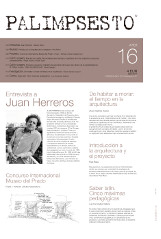Manufactura digital. Reconsideraciones teóricas y operativas en torno al ejercicio proyectual contemporáneo.
DOI:
https://doi.org/10.5821/palimpsesto.16.4873Palabras clave:
proyecto, teoría, práctica, representación, trabajo artesanal.Resumen
La integración de las fases de diseño, representación y fabricación que la tecnología digital permite, abre nuevas posibilidades al proyecto, reemplazando un proceso secuencial por otro simultáneo. Una simultaneidad que se vincula con una concepción artesanal y pre-moderna de la arquitectura. Los sistemas CAD/CAM establecen un puente de conexión interactivo entre la mente y la mano, entre creación y producción, posibilitando un desarrollo colaborativo del proyecto, desafiando la tradicional noción de autoría. Los puntos de contacto entre el trabajo artesanal y estas innovadoras tecnologías, permiten pensar a estas últimas como una suerte de manufactura digital, capaz de re-significar el vínculo entre conocimiento (software) y materialización (hardware), entre teoría y práctica . En este contexto, la presente investigación plantea una reflexión sobre las implicancias –teóricas y operativas– que esta incorporación tecnológica tiene o puede tener sobre la arquitectura y su desarrollo disciplinar, considerando además los desafíos planteados por la realidad contemporánea.
Publicado
Número
Sección
Licencia
CRITERIOS DE PROTECCIÓN Y PROPIEDAD INTELECTUAL
Los autores que publican en Palimpsesto están de acuerdo con los siguientes términos:
1. Los autores conservan los derechos de autor y garantizan a la revista el derecho de una Creative Commons Reconocimiento-NoComercial-SinObraDerivada (CC BY-NC-ND) que permite a otros compartir el trabajo con un reconocimiento de la autoría.
2. Los autores pueden establecer por separado acuerdos adicionales para la distribución no exclusiva de la versión de la obra publicada en la revista (por ejemplo, situarlo en un repositorio institucional o publicarlo en un libro).
3. Se permite y se anima a los autores a difundir sus trabajos electrónicamente (por ejemplo, en repositorios institucionales o en su propio sitio web) antes y durante el proceso de envío, ya que puede dar lugar a intercambios productivos, así como a una citación más temprana y mayor de los trabajos publicados (Véase The Effect of Open Access) (en inglés)
4. El autor o cedente del material que se entrega para publicación autoriza a la revista Palimpsesto para que publique, sin obligación alguna (económica o de otra naturaleza), el contenido del referido material tanto en formato papel, como en digital, así como en cualquier otro medio.
5. El autor o cedente garantiza ser el titular de los derechos de Propiedad Intelectural sobre los contenidos proporcionados, es decir, sobre el propio texto e imágenes/fotografías/obras fotográficas que se incorporan en su artículo.
6. El autor o cendente, exime a la revista Palimpsesto de toda y cualquier responsabilidad con relación a la violación de derechos de autor, comprometiéndose a emplear todos sus esfuerzos para auxiliar a la revista Palimpsesto en la defensa de cualquier acusación, medidas extrajudiciales y/o judiciales. Asimismo, asume el abono a la revista Palimpsesto de cualquier cantidad o indemnización que ésta tenga que abonar a terceros por el incumplimiento de estas obligaciones, ya sea por decisiones judicial, arbitral y/o administrativa.
7. El envío y su posterior aceptación de un texto por parte de los autores implica automáticamente la declaración de no plagio de su contenido







